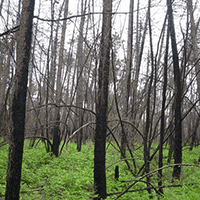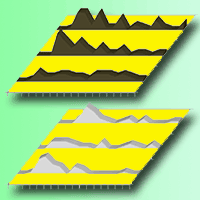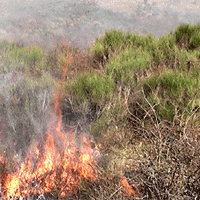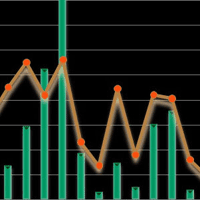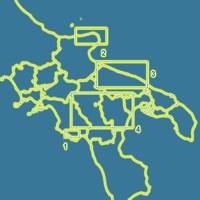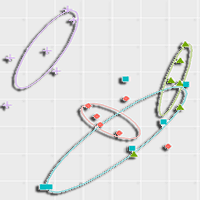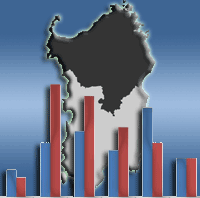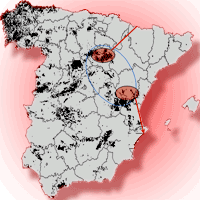The purpose of this study was to investigate the response of the soil microarthropod community to wildfire in forest ecosystems. The edaphic microarthropod communities of pine stands burned in 2001, in 2009, both in 2001 and in 2009, in 2012 were compared to an area never burned. Sampling was conducted in the spring and autumn of 2011 and 2012 in the areas burned in 2001, in 2009 and those never burned, while in the area burned in 2012, soil samples were collected in March (10 days after fire), June and September. The abundance and biodiversity of the microarthropod community were assessed. A multitemporal analysis was also carried out to assess the effect of fire on soil microarthropod abundance 5 months, 2-3 years and 10-11 years after fire. The results showed that the abundance of edaphic microarthropod communities decreased dramatically in areas burned twice, but also in areas burned once in 2009 and five months after the fire in the area burned in 2012. Different taxonomic groups did not seem to respond to fire in the same way, some taxa being more sensitive than others. Pseudoscorpionida decreased in both the short- and the long-term, while Diplopoda, Thysanoptera and Symphyla showed a reduction in the intermediate- and long-term. In the short-term, Diptera and Coleoptera larvae appeared to be the most influenced taxonomic groups. Our study shows that biomonitoring is a valuable tool to investigate the reaction of forest ecosystems to fire, and that edaphic microarthropods can provide interesting answers about the direct and indirect effects of fire on soil.
Keywords
, , ,
Citation
Lisa C, Paffetti D, Nocentini S, Marchi E, Bottalico F, Fiorentini S, Travaglini D (2015). Impact of wildfire on the edaphic microarthropod community in a Pinus pinaster forest in central Italy. iForest 8: 874-883. - doi: 10.3832/ifor1404-008
Academic Editor
Massimo Faccoli
Paper history
Received: Jul 21, 2014
Accepted: Jan 27, 2015
First online: May 05, 2015
Publication Date: Dec 01, 2015
Publication Time: 3.27 months
© SISEF - The Italian Society of Silviculture and Forest Ecology 2015
Open Access
This article is distributed under the terms of the Creative Commons Attribution-Non Commercial 4.0 International (https://creativecommons.org/licenses/by-nc/4.0/), which permits unrestricted use, distribution, and reproduction in any medium, provided you give appropriate credit to the original author(s) and the source, provide a link to the Creative Commons license, and indicate if changes were made.

Breakdown by View Type
(Waiting for server response...)
Article Usage
Total Article Views: 54953
(from publication date up to now)
Breakdown by View Type
HTML Page Views: 45615
Abstract Page Views: 3319
PDF Downloads: 4573
Citation/Reference Downloads: 22
XML Downloads: 1424
Web Metrics
Days since publication: 3900
Overall contacts: 54953
Avg. contacts per week: 98.63
Article Citations
Article citations are based on data periodically collected from the Clarivate Web of Science web site
(last update: Mar 2025)
Total number of cites (since 2015): 13
Average cites per year: 1.18
Publication Metrics
by Dimensions ©
Articles citing this article
List of the papers citing this article based on CrossRef Cited-by.
(1)
Abbott I (1984)Changes in the abundance and activity of certain soil and litter fauna in the Jarrah Forest of western Australia after a moderate intensity fire. Australian Journal of Soil Research 22: 463-469.
CrossRef |
Gscholar
(2)
Athias-Binche F (1987)Regeneration pattern of Mediterranean ecosystems after fire: the case of some soil arthropods: uropodid mites. Vie et Milieu 37: 39-52.
Gscholar
(3)
Bastida F, Zsolnay A, Hernández T, Garcia C (2008)Past, present and future of soil quality indices: a biological perspective. Geoderma 147: 159-171.
CrossRef |
Gscholar
(4)
Bedano JC, Cantù MP, Doucet ME (2006)Soil springtail (Hexapoda: Collembola), symphylans and pauropods (Arthopoda: Myriapoda) under different management system in agroecosystem of subhumid Pampa (Argentina). European Journal of Soil Biology 42: 107-119.
CrossRef |
Gscholar
(5)
Berlese A (1905)Apparecchio per raccogliere presto ed in gran numero piccoli Artropodi [Tool for quickly collecting small arthropods in large number]. Redia 2: 85-90. [in Italian]
Gscholar
(6)
Bezkorovainaya IN, Krasnoshchekova EN, Ivanova GA (2007)Transformation of soil invertebrate complex after surface fires of different intensity. Biology Bulletin 34: 517-522.
CrossRef |
Gscholar
(7)
Blondel J, Aronson J, Bodiou JY, Boeuf G (2010)The Mediterranean region: biological diversity in space and time. Oxford University Press, New York, USA, pp. 376.
Online |
Gscholar
(8)
Bonferroni CE (1935)Il calcolo delle assicurazioni su gruppi di teste [The calculation of the insurance on groups of heads]. In: “Studi in onore del Professore Salvatore Ortu Carboni”. Bardi ed., Rome, Italy, pp. 13-60. [in Italian]
Gscholar
(9)
Bonferroni CE (1936)Teoria statistica delle classi e calcolo delle probabilità [Statistical theory of classes and probability]. Pubblicazioni dell’Istituto Superiore di Scienze Economiche e Commerciali di Firenze 8: 3-62. [in Italian]
Gscholar
(10)
Broza M, Izhaki I (1997)Post-fire arthropod assemblages in Mediterranean forest soils in Israel. International Journal of Wildland Fire 7: 317-325.
CrossRef |
Gscholar
(11)
Broza M, Poliakov D, Weber S, Izhaki I (1993)Soil microarthropods on post-fire pine forest on Mount Carmel, Israel. Water Science and Technology 27: 533-538.
Online |
Gscholar
(12)
Buddle CM, Langor DW, Pohl GR, Spence JR (2006)Arthropod responses to harvesting and wildfire: implications for emulation of natural disturbance in forest management. Biological Conservation 128: 346-357.
CrossRef |
Gscholar
(13)
Camann MA, Gillette NE, Lamocha L, Mori SR (2008)Response of forest soil Acari to prescribed fire following stand structure manipulation in the southern Cascade Range. Canadian Journal of Forest Research 38: 956-968.
CrossRef |
Gscholar
(14)
Clarke KR (1993)Non-parametric multivariate analysis of changes in community structure. Australian Journal of Ecology 18: 117-143.
CrossRef |
Gscholar
(15)
Coleman TW, Rieske LK (2006)Arthropod response to prescription burning at the soil-litter interface in oak-pine forests. Forest Ecology and Management 233: 52-60.
CrossRef |
Gscholar
(16)
Cuchta P, Miklisová D, Kováč L (2012a)European montane spruce forests 2 years after disturbance by fire. Annals of forest Science 69 : 81-92.
CrossRef |
Gscholar
(17)
Cuchta P, Miklisová D, Kováč L (2012b)The impact of disturbance and ensuing forestry practices on Collembola in monitored stands of windthrown forest in the Tatra National Park (Slovakia). Environmental Monitoring and Assessment 185 (6): 5085-5098.
CrossRef |
Gscholar
(18)
Dale VH, Beyeler SC (2001)Challenges in the development and use of ecological indicators. Ecological Indicators 1: 3-10.
CrossRef |
Gscholar
(19)
Davis JC (1986)Statistics and data analysis in geology. Wiley, New York, USA, pp. 646.
Gscholar
(20)
DeBano LF, Neary DG, Ffolliott PF (1998)Fire Effects on Ecosystems. John Wiley & Sons, New York, USA, pp. 333.
Online |
Gscholar
(21)
Dress WJ, Boerner RE (2003)Patterns of microarthropod abundance in oak-hickory forest ecosystems in relation to prescribed fire and landscape position. Pedobiologia 48: 1-8.
CrossRef |
Gscholar
(22)
Fernandez I, Cabaneiro A, Carballas T (1997)Organic matter changes immediately after a wildfires in an atlantic forest soil and comparison with laboratory soil heathing. Soil Biology and Biochemistry 29: 1-11.
CrossRef |
Gscholar
(23)
Frampton GK, Van Den Brink PJ, Gould PJL (2000)Effects of spring drought and irrigation on farmland arthropods in southern Britain. Journal of Applied Ecology 37: 865-883.
CrossRef |
Gscholar
(24)
García-Ruiz A (2001)Estudio de los efectos de un incendio sobre las poblaciones de miriàpodos [Study of the effects of fire on populations of miriapodes]. Ecología 15: 269-273. [in Spanish]
Gscholar
(25)
Gillson L (2009)Landscape in time and space. Landscape Ecology 24: 149-155.
CrossRef |
Gscholar
(26)
Grabcizynska O, Olejniczak I, Predecka A, Russel S (2009)Short term effect of prescribed forest fire on soil mites. Short research contribution. Polish Journal of Ecology 57: 805-809.
Gscholar
(27)
Granström A (2001)Fire management for biodiversity in the European boreal forest. Scandinavian Journal of Forest Research 3: 62-.69.
CrossRef |
Gscholar
(28)
Hadjibiros K (2001)Setting priorities for wildfire suppression policy in Greece, using a relation between year burned areas and recovery time. Global Nest: The International Journal 3: 37-43.
Online |
Gscholar
(29)
Hammer O, Harper DAT, Ryan PD (2001)PAST: palaeontological statistics software package for education and data analysis. Palaeontologia Electronica 4: 9-9.
Online |
Gscholar
(30)
Harper DAT (1999)Numerical palaeobiology. Wiley, Chichester, UK, pp. 468.
Gscholar
(31)
Heneghan L, Bolger T (1998)Soil microarthropod contribution to forest ecosystem processes: the importance of observational scale. Plant and Soil 205: 113-124.
CrossRef |
Gscholar
(32)
Huebner KR, Lindo Z, Hyperlink MJ (2012)Post-fire succession of collembolan communities in a northern hardwood forest. European Journal of Soil Biology 48: 59-65.
CrossRef |
Gscholar
(33)
Jackson DA (1993)Stopping rules in principal components analysis: a comparison of heuristical and statistical approaches. Ecology 74: 2204-2214.
CrossRef |
Gscholar
(34)
Jalaluddin M (1969)Micro-organic colonization of forest soil after burning. Plant and Soil 30: 150-152.
CrossRef |
Gscholar
(35)
Jongman RHG, Ter Braak CJF, Van Tongeren OFR (1995)Data analysis in community and landscape ecology. Cambridge University Press, Cambridge, UK, pp. 299.
Online |
Gscholar
(36)
Karr JR (1991)Karr JR (1991) Biological integrity: a long neglected aspect of water resource management. Ecological Applications 1: 66-84.
Online |
Gscholar
(37)
Kautz T, Lòpez-Fando C, Ellmer F (2006)Abundance and biodiversity of soil microarthropods influenced by different types of organic manure in a long-term field experiment in Central Spain. Applied Soil Ecology 33: 278-285.
CrossRef |
Gscholar
(38)
Keeley JE (2009)Fire intensity, fire severity and burn severity: a brief review and suggested usage. International Journal of Wildland Fire 18: 116-126.
CrossRef |
Gscholar
(39)
Khanna PK, Raison RJ, Falkiner RA (1994)Chemical properties of ash derived from Eucalyptus litter and its effects on forest soils. Forest Ecology and Management 66: 107-125.
CrossRef |
Gscholar
(40)
Koponen S (1995)Postfire succession of soil arthropod groups in a subarctic birch forest. Acta Zoologica Fennica 196: 243-245.
Gscholar
(41)
Köppen W (1936)Das geographische System der Klimate [The geographic system of climates]. In: “Handbuch der Klimatologie” (Köppen W, Geiger R eds). IC, Berlin, Germany, pp. 44. [in German]
Gscholar
(42)
Kremen C (2005)Managing ecosystem services: what do we need to know about their ecology? Ecology Letters 8: 468-479.
CrossRef |
Gscholar
(43)
Kruskal WH, Wallis WA (1952)Use of ranks in one-criterion variance analysis. Journal of the American Statistical Association 47: 583-621.
CrossRef |
Gscholar
(44)
Lagerlöf J, Scheller U (1989)Abundance and activity of Pauropoda and Symphyla (Myriapoda) in four cropping systems. Pedobiologia 33: 315-321.
Online |
Gscholar
(45)
Lussenhop J (1992)Mechanism of microarthropods-microbial interaction in the soil. Advances in Ecological Research 23: 1-33.
CrossRef |
Gscholar
(46)
Magurran AE (1988)Ecological diversity and its measurement. Princeton University Press, New York, USA, pp. 192.
Online |
Gscholar
(47)
Magurran AE (2004)Measuring biological diversity. Blackwell Sciences, Oxford, UK, pp. 215.
Gscholar
(48)
Majer JD (1980)Report on a study of invertebrates in relation to the Kojonup Nature Reserve Fire Management Plan. Departmental Technical Report, Western Australian Institute of Technology, Bentley, Australia, pp. 25.
Online |
Gscholar
(49)
Majer JD (1984)Short term responses of soil and litter invertebrates to a cool autumn burn in Jarrah (
Eucalyptus marginata) forest in Western Austalia. Pedobiologia 26: 229-247.
Online |
Gscholar
(50)
Malmström A (2010)The importance of measuring fire severity - Evidence from microarthropod studies. Forest Ecology and Management 260 (1): 62-70.
CrossRef |
Gscholar
(51)
Malmström A (2012)Life-history traits predict recovery patterns in Collembola species after fire: a 10 year study. Applied Soil Ecology 56: 35-42.
CrossRef |
Gscholar
(52)
Malmström A, Persson T, Ahlström K (2008)Effects of fire intensity on survival and recovery of soil microarthropods after a clear-cut burning. Canadian Journal of Forest Research 38 (9): 2465-2475.
CrossRef |
Gscholar
(53)
Marshall VG (2000)Impacts of forest harvesting on biological process in northern forest soils. Forest Ecology and Management 133 (1-2): 43-60.
CrossRef |
Gscholar
(54)
Moreira F, Rego FC, Ferreira PG (2001)Temporal (1958-1995) pattern of change in a cultural landscape of northwestern Portugal: implications for fire occurrence. Landscape Ecology 16 (6): 557-567.
CrossRef |
Gscholar
(55)
Moretti M, Obrist MK, Duelli P (2004)Arthropod biodiversity after forest fires: winners and losers in the winter fire regime of the southern Alps. Ecography 27 (2): 173-186.
CrossRef |
Gscholar
(56)
Moretti M, Duelli P, Obrist MK (2006)Biodiversity and resilience of arthropods communities after fire disturbance in temperate forests. Oecologia 149 (2): 312-327.
CrossRef |
Gscholar
(57)
Murunga M (2013)Assessment of short term effects of soil arthropods in the Aberdare National Park Kenya. BSc dissertation, School of Biological Sciences, University of Nairobi, Kenya, pp. 28.
Online |
Gscholar
(58)
Neary DG, Klopatek CC, DeBano LF, Ffolliott PF (1999)Fire effects on belowground sustainability: a review and synthesis. Forest Ecology and Management 122 (1-2): 51-71.
CrossRef |
Gscholar
(59)
Nelson DW, Sommers LE (1996)Total carbon, organic carbon, and organic matter. In: “Methods of Soil Analysis: Part 3 - Chemical Methods” (Sparks DL, Page AL, Helmke PA, Loeppert RH, Soltanpour PN, Tabatabai MA, Johnston CT, Sumner ME eds). SSSA Book Series No. 5, Soil Science Society of America, Madison, WI, USA, pp. 961-1010.
Online |
Gscholar
(60)
Nimis PL, Scheidegger C, Wolseley PA (2002)Monitoring with lichens - monitoring lichens. NATO Science Series vol. 7, Springer, The Netherlands, pp. 1-4.
CrossRef |
Gscholar
(61)
Nocentini S, Bottalico F, Faraoni L, Fiorentini S, Lisa C, Marchi E, Neri F, Paffetti D, Piemontese FP, Puletti N, Travaglini D (2011)Piano di gestione del consorzio forestale delle Cerbaie 2012-2026 [The forest management plan 2012-2026 of the Cerbaie forest consortium]. Università degli Studi di Firenze, Dipartimento di Economia, Ingegneria, Scienze e Tecnologie Agrarie e Forestali, Florence, Italy, pp. 34-36. [in Italian]
Gscholar
(62)
Norton RA (1985)Aspects of the biology and systematics of soil arachnids, particularly saprophagous and mycophagous mites. Quaestiones Entomologicae 21: 523-541.
Gscholar
(63)
Olivari S (2004)Morfologia, geologia e pedologia [Morphology, geology and soil science]. In: “La Riserva Naturale di Montefalcone: storia, ambiente e territorio” (Cappelli F, Cappelli V, Fabbrizzi F, Olivari S, Piussi P, Sbragia M, Stiavelli S eds). Tipografia La Grafica Pisana, Pisa, Italy, pp. 21-30. [in Italian]
Gscholar
(64)
Paquin P, Coderre D (1997)Deforestation and fire impact on edaphic insect larvae and other macroarthropods. Environmental Entomology 26 (1): 21-30.
CrossRef |
Gscholar
(65)
Pausas JG (2004)Changes in fire and climate in the eastern Iberian Peninsula (Mediterranean Basin). Climatic Change 63 (3): 337-350.
CrossRef |
Gscholar
(66)
Pielou EC (1984)The interpretation of ecological data. Wiley-Interscience Publication, John Wiley and Sons, New York, USA, pp. 263.
Gscholar
(67)
Raymond CL, Peterson DL (2005)Fuel treatments alter the effects of wildfire in a mixed- evergreen forest, Oregon, USA. Canadian Journal of Forest Research 35 (12): 2981-2995.
CrossRef |
Gscholar
(68)
Ream CH (1981)The effects of fire and other disturbances on small mammals and their predators: an annotated bibliography. Gen. Tech. Rep. INT-106, Intermountain Forest and Range Experiment Station, USDA Forest Service, Ogden, UT, USA, pp. 55.
Online |
Gscholar
(69)
Roloff GJ, Mealey SP, Clay C, Barry J, Yanish C, Neuenschwander L (2005)A process for modeling short- and long-term risk in the southern Oregon Cascades. Forest Ecology and Management 211 (1-2): 166-190.
CrossRef |
Gscholar
(70)
Saarsalmi A, Melkönen E, Piirainen S (2001)Effects of wood ash fertilization on forest soil chemical properties. Silva Fennica 35 (3): 355-368.
CrossRef |
Gscholar
(71)
Santalla S, Salgado JM, Calvo L, Fernandez MMF (2002)Changes in the Carabidae community after a large fire in a
Pinus pinaster stand. In: “Fire and Biological Processes” (Trabaud L, Pradon R eds). Backhuys Publishers, Leiden, The Netherlands, pp. 215-231.
Gscholar
(72)
Saulnier L, Athias-Binche F (1986)Modalités de la cicatrisation des écosystème méditerranéens aprés incendie: cas de certains arthropodes du sol 2. Les myriapodes édaphiques [Methods of recovering of Mediterranean ecosystem after fire: the case of some soil arthropods 2. Soil Myriapods]. Vie Milieu 36: 191-204. [in French]
Gscholar
(73)
Sbragia M (2004)Il clima. In: “La Riserva Naturale di Montefalcone: storia, ambiente e territorio” [The climate. In: “The Montefalcone natural reserve: history, environment and territory”] (Cappelli F, Cappelli V, Fabbrizzi F, Olivari S, Piussi P, Sbragia M, Stiavelli S eds). Tipografia La Grafica Pisana, Pisa, Italy, pp. 15-20. [in Italian]
Gscholar
(74)
Seastedt TR (1984)The role of microarthropods in decomposition and mineralization process. Annual Review of Entomology 29: 25-46.
CrossRef |
Gscholar
(75)
Seastedt TR, Crossley DA (1984)The influence of arthropods on ecosystems. BioScience 34: 157-161.
CrossRef |
Gscholar
(76)
Sgardelis SP, Pantis JD, Argyropoulou MD, Stamou GP (1995)Effects of fire on soil macroinvertebrates in a Mediterranean Phryganic ecosystem. International Journal of Wildland Fire 5: 113-121.
CrossRef |
Gscholar
(77)
Shannon CE, Weaver W (1962)The mathematical theory of communication. University of Illinois Press, Urbana, IL, USA.
Gscholar
(78)
Silveira JM, Barlow J, Louzada J, Mountinho P (2010)Factors affecting the abundance of leaf-litter arthropods in unburned and thrice-burned seasonally-dry Amazonian forests. PloS ONE 5 (9): e12877.
CrossRef |
Gscholar
(79)
Simpson EH (1949)Measurement of diversity. Nature 163: 688-688.
CrossRef |
Gscholar
(80)
Spellerberg IF (1991)Monitoring ecological change. Cambridge Unviersity Press, Cambridge, UK, pp. 181-182.
Gscholar
(81)
Striganova BR (2000)Locomotory and trophic activity of invertebrates as a factor of soil structure formation. Eurasian Soil Science 33: 1094-1100.
Online |
Gscholar
(82)
Tajovský K (2002)Soil macrofauna (Diplopoda, Chilopoda, Oniscidea) in a pine forest disturbed by wild fire. In: Proceedings of the “6th Central European Workshop on Soil Zoology: Studies on soil fauna in Central Europe” (Tajovský K, Balik V, Pižl V eds). Ceské Budejovice (Czech Republic) 23-25 Apr 2001, pp. 227-232.
Gscholar
(83)
Thornthwaite CW (1948)An approach toward a rational classification of climate. Geographical Reviews 38: 55-94.
CrossRef |
Gscholar
(84)
Trucchi E, Pitzalis M, Zapparoli M, Bologna MA (2009)Short-term effects of canopy and surface fire on centipede (Chilopoda) communities in a semi natural Mediterranean forest. Entomologica Fennica 20: 129-138.
Online |
Gscholar
(85)
Tüllgren A (1918)Ein sehr einfacher Ausleseapparat für terricole Tierfaunen [A simple tool for sampling soil fauna]. Zeitschrift für angewandte Entomologie 4: 149-150. [in German]
Gscholar
(86)
Vincent K, Moening K, Colter H (2009)Effects of annual fire on the litter fauna populations and soil compositions of an upland white-oak forest. Journal of Prairie Restoration Research 6: 17-20.
Gscholar
(87)
Wallwork JA (1983)Oribatei in forest ecosystem. Annual Review of Entomology 28: 109-130.
CrossRef |
Gscholar
(88)
Wikars LO, Schimmel J (2001)Immediate effects of fire-severity on soil invertebrates in cut and uncut pine forests. Forest Ecology and Management 141: 189-200.
CrossRef |
Gscholar
(89)
Won Kim J, Jung C (2008)Abundance of soil microarthropods associated with forest fire severity in Samcheok, Korea. Journal of Asia-Pacific Entomology 11: 77-81.
CrossRef |
Gscholar
(90)
York A (1999)Long-term effects of frequent low-intensity burning on the abundance of litter-dwelling invertebrates in coastal blackbutt forests of southeastern Australia. Journal of Insect Conservation 3: 191-199.
CrossRef |
Gscholar
